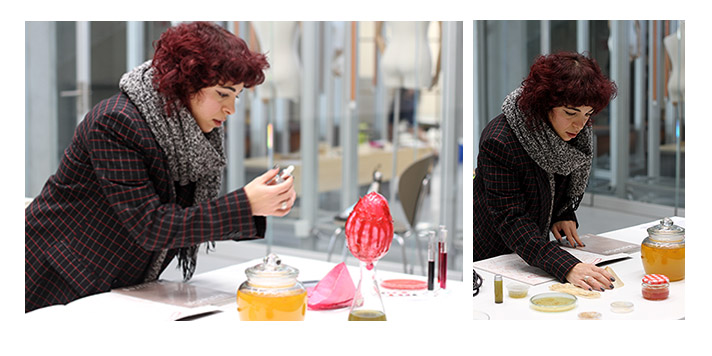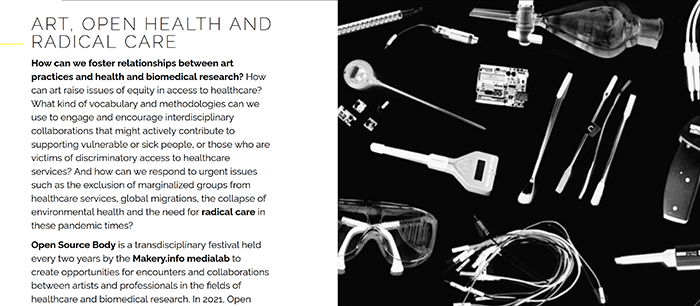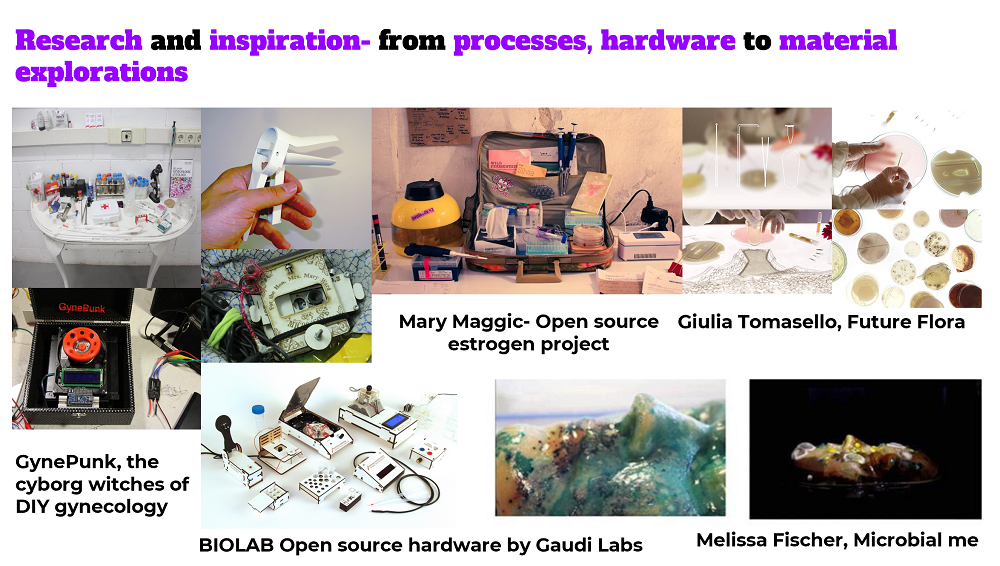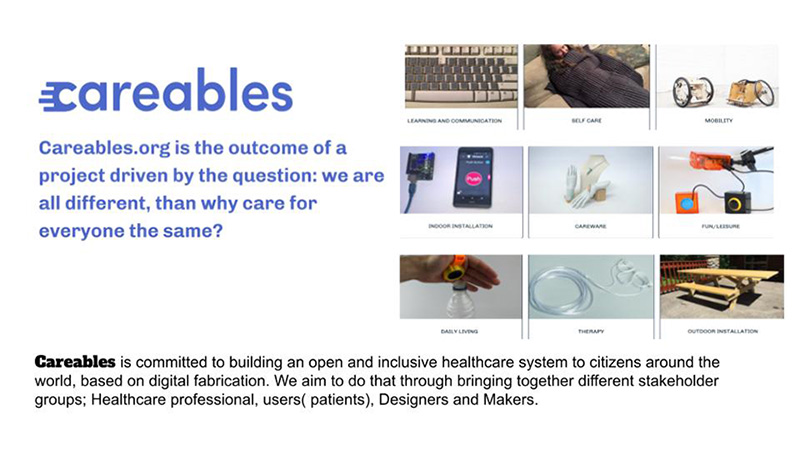I. Final Project brainstorming¶

Soooooo! The time has come. I have started researching and designing the concept of my final project, planning my calendar, materials, processes and documenting my explorations!
The first thing I did was to create and bring together a COMMUNITY around the OPEN SOURCE BODY/HEALTH/CARE and find potential collaborators, contributors, people to interview, involve potential audience and communities around my project!
So for this semester I started up with:
-Setting up my final project page
-Document the concept, sketches, artistic and scientific references
-Creating a GANTT chart (planning calendar)
-Answering the 5W: Who, What, When, Where, Why
-Creating a quick prototype of my concept/intimate lab experience. (physical, digital, collage or render)
Final project concept¶

Images by our instructor and mentor Betiana Pavon
An intimate concept and sensory DIY biolab experience for bodily exploration that is guided by material driven research, DIY Biology, biohacking, biochrome techniques, biofabrication and digital fabrication. Through these techniques and processes I want to create my own tools and instruments for self healing, experimentation and exploration and investigate possible application scenarios and speculations of my grown, cultivated and crafted materials.
Some of my speculations and application scenarios:
What if we can grow our own healing 2nd skin? What if our own cells, fluids and other biological materials can become the source for self healing and scientific and artistic self exploration? What if we can cultivate our own microorganisms for a healthy body, skin and our own microflora at home? What if we can create new organs and repair existing ones? What if we can create our vessels to store our own bodily fluid? What if our body is or can become an open abundant source of biological materials for scientific and artistic exploration? What if we can re learn to care for ourselves and more-than human others through the process of biodesign, biofabrication, DIY biology and digital fabrication?
What is the FUTURE OF MEDICINE AND BIOTECHNOLOGY?
And the most important part of the project-
Through my project I try to answer questions about the future of self care and health/care and try to motivate and empower my audience to become more active in their own self care but also in the care for more-than human living beings and natural systems. I would like to re imagine but also challenge the future and design of medical and health/care technologies as well as challenge traditional patient-doctor patriarchal relationships.
First of all, last year I came across the OPEN SOURCE BODY transdisciplinary festival held every two years by the Makery medialab. The festival aimed to create opportunities for encounters and collaborations between artists and professionals in the fields of healthcare and biomedical research. My project is clearly influenced and inspired by that too, however I wanted to take the concept of the open source body and expand it in my project.


Research and inspiration¶
I have been researching DIY Biology, biohacking and open source healthcare in an artistic and design context for a while now. Pretty much right before I participated with the bioart coven class at the School of machines in Berlin and then met some amazing people and bioartists like WhiteFeather Hunter and many of the other coven members.
Since 2013 I have been mesmerised with the tools, instruments, techniques, materials and processes of knowledge production across the disciplines of anatomy, biology and natural history histology and in the intersection of science, art, and tech.
I am pretty much into medical instruments, tools, hardware, protocols (Recipes and know-how guides like manuals and instruction booklets), biofabricated and crafted materials.

DIY BIOLOGY in biofabrication, biodesign and material science¶
DIY BIOLOGY, takes cues from computer-hacking culture and uses the tools of biological science and biotechnology to carry out experiments and make tools outside any formal research institution.It democratises and demystifies biotechnology and science as it makes them accessible to all.
When biofabricating materials and designing and working with living organisms we very often have to use step into a biolab, a space where we create the suitable conditions to work with cultivated materials and develop DIY tools. The tools and processes of a biodesigner and material designer are very similar to the ones of a bioartist or someone who practices DIY Biology!
OPEN SOURCE DIY BIOTECH¶
In time of a crisis, digital fabrication and open source designs are cultivating and spreading the care by disseminating open protocols for coronavirus tests, to open insulin, to tools for gynecological exploration and care. For myself, every day is an emergency in our contemporary dystopian world. The fact that through open source principles we can sort of help to make this world better, in terms of caring especially, really empowers me and gives me a little hope!
Go here to check this 3D print exchange library from the National Institute of health with some digitally fabricated designs, from medical/anatomical models, to labware and medical devices

Another project that really inspired me is the careables project.
Tools for gyne exploration (autoexploration) and emergency gynecologist kit¶
The only criteria I would apply to consider yourself GynePunk is reclaiming your body by Klay Kinky, member of the radical bio-hacker collective of transHackFeminists, GynePunk.
The collective GynePunk has created open-source tools for DIY diagnosis and first-aid care—centrifuges made from old hard drive motors; microscopes from deconstructed webcams; homemade incubators; and 3D printable speculums for cervical exploration.
If you want to print the speculum you can go here. There is also a nice method comparison for 3D printing this in here.
Paula Pin, another member of the collective has stated-
This hacker mentality, for me, serves as a new way to understand the world around us, and gives us many tools to develop and generate our own technologies. We understand our body also as a technology to be hacked, from the established ideas of gender and sex, to exploring the capacity to start researching ourselves, to find our own ideas and technologies, to help us be free, autonomous and independent from the system."
In one of GynePunk'sworkshop at Hangar in Barcelona,named CABINET de CURIOSIDADES, gYNEpuNK biolabs & otras biolencias, they developed a biolab emergency box.
The aim was to assemble DIY biohacking tools to analyze body fluids : blood, urine, vaginal fluids. Aided by the Hackteria network, GynePunk developed three tools : a centrifuge, a microscope and an incubator. The centrifuge separates solids from liquids, and decants the contents for examination under the microscope. The microscope, a useful tool for cytology (the study of cell morphology) and histology (tissue morphology), is used to identify (by color) urinary and other genital fungal infections. Finally, the incubator grows the bacteria in a Petri dish, feeding them to reveal their presence.
“We are cyborg witches!” says Paula
>“We want to update ancestral knowledge with the independent use of technology.”
Useful links¶
-National Institute of Health 3D print exchange library
-Bio-reSEARCH, GYNEpunk: Autonomous gynecologyLAB @ Hackteria.org
-Renewable products from human belly button basteria
-CAREABLES, an open and inclusive approach to healthcare.
-GynePunk's workshop at Hangar in Barcelona
-Research Article-The Promissory Visions of DIYbio: Reimaging Science from the Fringe
-Cyborg witches of autoynecology